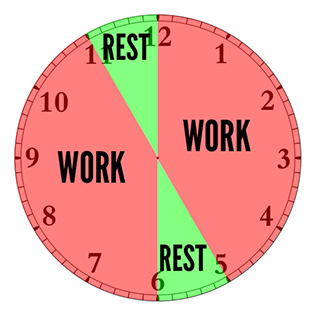
Anders Ericsson’s research on the 10.000 hour rule to achieve mastery has become a corner-stone to every world-class achiever’s frame of mind.
10.000 hours of deliberate practice equals 10 years of hard work. There upon one should ask: how should the work load be distributed through all of those years, months, weeks days and even hours?
So far we’ve focused our attention over the best ways to practice, meaning, how to use time while we’re actively engaged at practicing and performing our art, craft or instrument. What about resting? When is the best time to say: “Let’s take a break” or Let’s call it a day”.
What is the ideal attention span of concentration? How much time can one remain focused and engaged in a given activity? How much recovery time is needed before re-engaging properly in the task at hands?
Deliberate practice can be draining and can even start producing undesired mindless practices.
- One needs to re-fuel the body-mind tank before taking another go (resource theory).
- At the same time, the brain is stimulated by novelty and shuts down with repetition so one should be aware when enough is enough (mindless theory).
The resource theory
For starters, the work-rest ratio is not stagnant and may vary widely from person to person. If you think about all the different lengths of classes you took from kindergarten to college you might realise there are some wild differences between teacher’s lecture and recess: 45/15 or 50/10 or 90/30 and so on.
There’s actually a technique called “The Pomodoro” which helps you achieve a high state of productivity by setting a timer for only 25 minutes a session. Goals must be objective and the short duration of the practice session may burst your motivation into higher grounds. 25 minutes may start seeming a long period for absolute focused attention but reveal to be a short period to nail your goal. Who wouldn’t be excited to resume the practice session for another 25 minutes?
Let me give you an example: If you’re currently maximizing your performance by practicing deliberately for 4 hours a day try re-schedule your working sessions as follows:
- Set the Pomodoro timer for 25 minutes;
- Take a 5 minute break;
- Resume the Pomodoro for another 25 minutes;
- Schedule the procedure for 4 spaced times of the day;
- Choose 8 topics to work on (one for each Pomodoro);
- If you like a more interleaved practice choose only 3 or 4 topics and work on each randomly throughout each 25 minute session.
Despite the fact that each of us has a personal length for recovery it seems quite universal that the more intense the activity and engagement is the more recovery rest is needed.
More so, what we do in our rest periods seems to have great impact in our ability to re-connect further on up the road. Are we actually resting and re-fuelling the mind and body? Do we take the time to meditate, breathe fresh air, take a walk, have a chat with a friend, stretch, eat, drink water… unwind and switch to defuse mode?
Or are we toasting the last brain cells we’ve got left with a stressful argue, intense puzzle or quiz solving, strenuous physical activities, anxious email/phone call/Facebook checking or attending noisy rooms?
Keep in mind that when deliberate focusing your attention into the instrument you microscopically funnel brain resources into one specific action: Precision and accuracy of movement, aka: Mastery.
Rest, on the other hand, allows your brain to unwind and release that specific area of your brain by going into defuse mode. This is where you connect several unrelated chunks or ideas and come up with new and original perspectives and solutions.
The mindless theory
If the need for rest is a sign of boredom or disengagement consequent of the repetition process of the practice session, then another strategy will come in handy.
Step by step, the unfamiliar or demanding musical phrase becomes accessible and, eventually, routine. Here’s were attention fades out and we start daydreaming.
“Nothing fails like success” (Robin Sharma). It’s true! Once you nail it you start getting sloppy. You think it’s ok to miss one routine or workout and soon you’ll be missing a whole practice session. You become used to it, you’ve grown accustomed to it and it’s not challenging anymore… “The Thrill is Gone” (B.B. King).
The trick is to play it like a video game. When it becomes manageable you switch from Rookie to All-Star and eventually to Hall Of Fame level. Gradually increase the amount of musical elements in your playing and your interest in the practice session will remain longer.
1 – Start by playing a musical phrase;
2 – Add rhythmical nuances, make it swing, make it groovy;
3 – Build on dynamics (legato, staccato, pick, thumb, bend, slide, hammer-on, pull-off, octave);
4 – Ear it in your mind before playing it;
5 – Sing it;
6 – Focus on any body tension;
7 – Build speed.
Oh, here’s my Pomodoro ringing again! That’s it for today. Class dismissed. See you next Sunday 🙂


